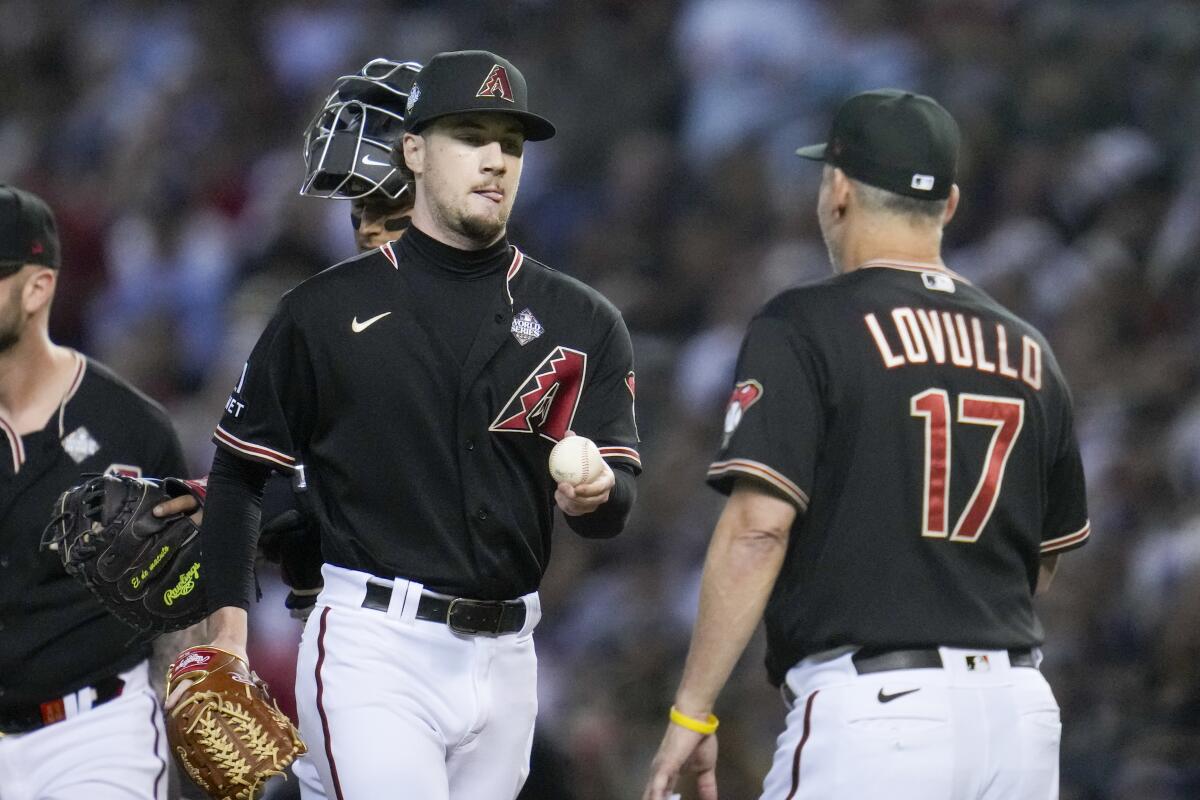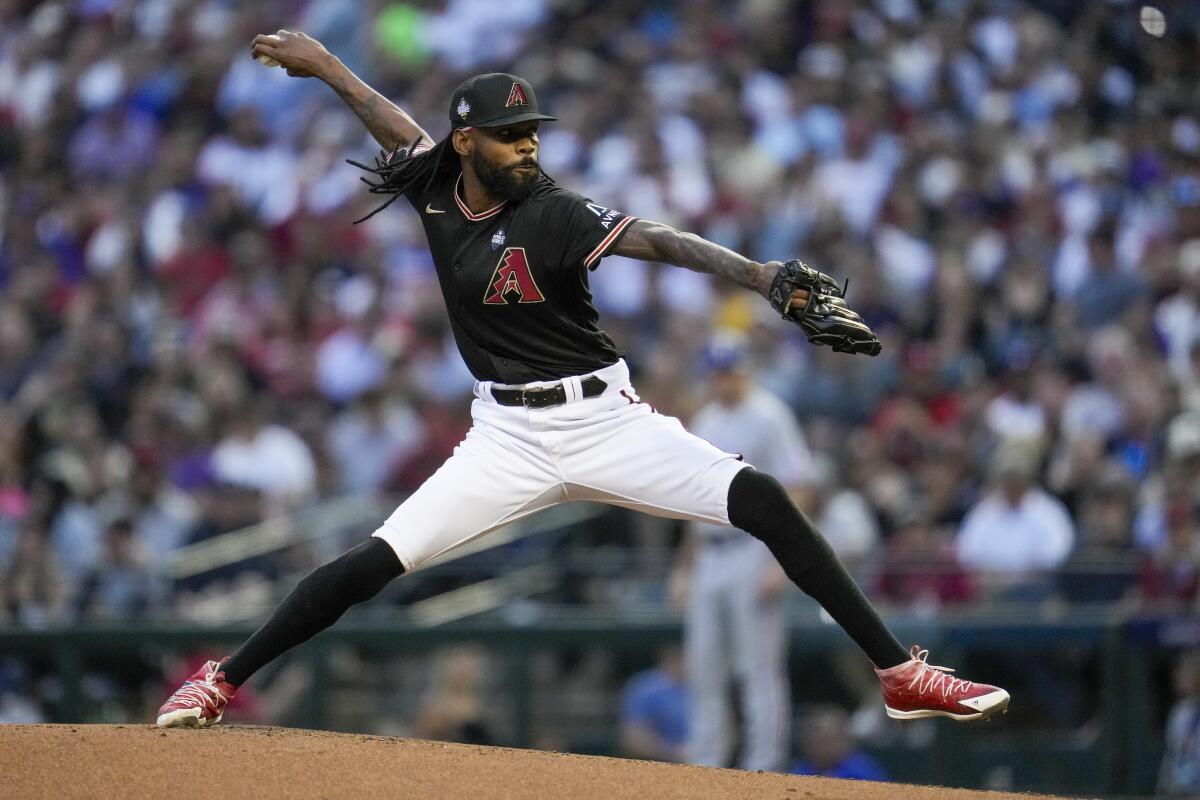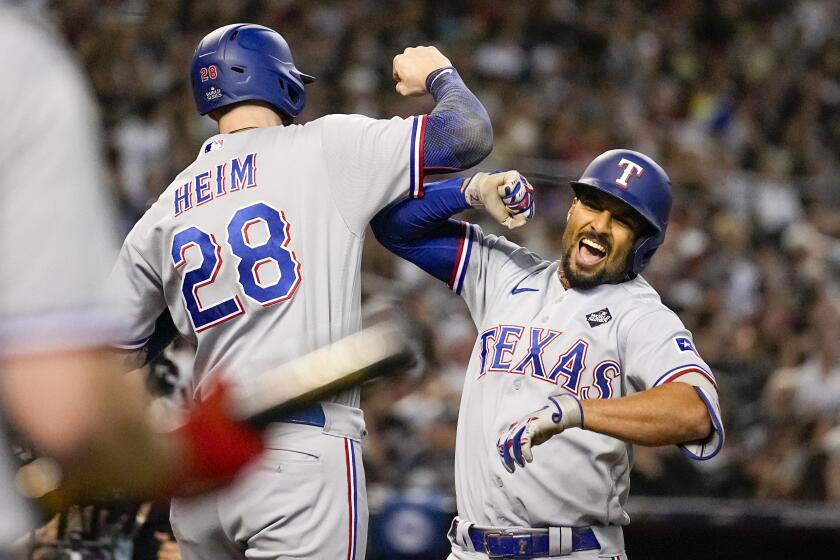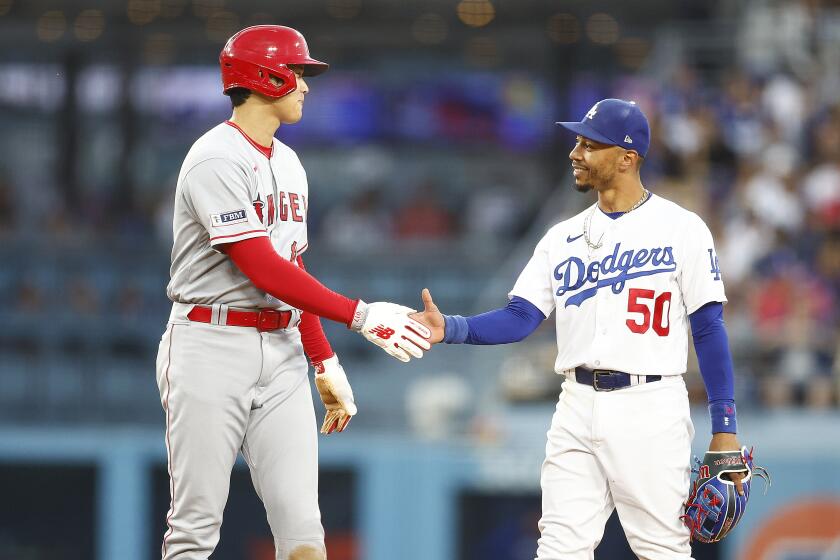Rob Manfred called bullpen games a problem. Then Arizona had one in the World Series

- Share via
PHOENIX — The desire to optimize every facet of every inning of every game over almost everything across Major League Baseball front offices was the genesis for the press box announcement during the first inning of Game 4 of the World Series on Tuesday: The Arizona Diamondbacks, three pitches into the game, had a reliever warming in the bullpen.
They also had a reliever on the mound. A decade ago, that would’ve meant something disastrous happened. But nothing was awry — yet. This was the plan. The Diamondbacks, facing a two-games-to-one series deficit, were intentionally utilizing a bullpen game against the Texas Rangers at Chase Field.
Joe Mantiply, the reliever on the mound, was the team’s “opener.” It was the veteran left-hander’s second start of the postseason, fifth start in 2023, and fifth career start. He retired the Rangers’ side in order in the first inning before facing two batters and giving up a double in the second inning. It was the beginning of a debacle.
The Diamondbacks used three pitchers over the next two innings. The trio combined to surrender 10 runs, all with two outs, as the Rangers built a huge lead en route to moving to within one win of the first championship in franchise history with an 11-7 victory.
Ryne Nelson, the Diamondbacks’ No. 4 starter, was the team’s most effective pitcher. He entered the game in the fourth inning and held the Rangers to one run over 5 ⅓ frames. He was one of six pitchers Arizona used.
The Rangers countered with a traditional starter, former Dodger and Angel Andrew Heaney. The left-hander limited the Diamondbacks to one run over five innings.
“Starting pitching is a premium,” Diamondbacks manager Torey Lovullo said before the game. “We know that. And if you’ve got quality arms, we’re going to use them. We just feel like there’s a balance there where there might be a dropoff with some of the starters that we do have or potentially could use here.”
In Major League Baseball Commissioner Rob Manfred’s ideal world, Nelson would have gotten the start Tuesday for the Diamondbacks because the pitching strategy they used wouldn’t be a viable option — especially not on the sport’s biggest stage.
“I do think that, historically, starting pitchers have been some of the biggest stars in the game,” Manfred said before Game 1 of the World Series. “And I think the way that pitching’s being used right now has caused a diminution in that kind of star quality for some of our starters and I think it’s an issue that we should talk about.”
Marcus Semien had five RBI’s, Corey Seager hit a home run and the Texas Rangers beat the Arizona Diamondbacks 11-7 to take a 3-1 World Series lead.
MLB’s first step in addressing the problem was imposing a limit of 13 pitchers per team last June. Reducing the number of pitchers on a roster forces pitchers on the roster to log more innings. Theoretically, starting pitchers would pitch deeper into games.
Manfred said he wants to drop the limit further, but a change wouldn’t happen for the 2024 season.
“We went to 13,” Manfred said. “I don’t think it’s had the desired effect.”
For teams, relying on a quality starting pitcher is always preferred over a bullpen game. There is a measure of unpredictability in summoning a different pitcher for every inning. Relievers are usually relievers for one reason: they’ve been deemed not good enough to be starters. But a combination of starting pitchers not developing like they used to and a constant search for every edge led to a change over the last five years.
The Tampa Bay Rays became the first organization in the majors to regularly use a reliever to open games before giving the ball to a pitcher stretched out to log multiple innings — a traditional starter masquerading as a “bulk guy” — or turning to a stream of relievers in 2018. The tactic was met with curiosity and skepticism.
For the Rays — an innovative, small-market operation — the strategy was a way to maximize their pitching staff to keep up with the bigger spenders in their division. Those teams could afford the best pitchers in free agency, the idea went, and the Rays couldn’t compete with them in that department over a 162-game season.
The initial consensus was the strategy wouldn’t spread to teams that have the money to spend on good starting pitchers because good starting pitching was part of the formula to win championships. The idea was too wacky. Baseball purists balked at the notion.

Then teams in every tax bracket started copying them because in a world in which relievers with 98-mph fastballs and wipeout stuff in one-inning spurts became the norm, dividing the workload more aggressively was often more effective than using a below-average starting pitcher.
“I hated it,” Dodgers manager Dave Roberts said. “It wasn’t baseball.”
Roberts said that in October 2021 after having Corey Knebel, a reliever, start Game 1 of the National League Championship Series against the Atlanta Braves because Max Scherzer had closed Game 5 of the previous series. The Dodgers, with the highest payroll in the majors that year, lost that bullpen game, 3-2.
A week later, Clayton Kershaw, arguably the best starting pitcher in the majors since the turn of the century, noted the inherent issue with the strategy.
“There’s a definite — I don’t want to say ‘disconnect,’” Kershaw said, between “fans and the entertainment side of it, and then based on what is actually working.”
The postseason format, which grants teams more off-days than during the regular season, has allowed for clubs to mostly rely on just three starting pitchers with success in recent years. The 2019 Washington Nationals and 2021 Atlanta Braves won the World Series with that formula. The 2022 Philadelphia Phillies almost did. And now the Diamondbacks are giving it a try.
There probably weren’t many people who changed the channel just because Mantiply opened Tuesday’s game. But nobody was tuning in to watch him either. And for a series that already had attracted two of the three smallest television audiences in World Series history, not having a marquee starting pitching matchup as an attraction doesn’t help.
The Dodgers have a long list of things they want to accomplish this offseason, the biggest being their pursuit of a certain free agent last seen in Anaheim.
“I think that there’s a lot of fans who feel like the change from ‘Let’s see who today’s pitching matchup is’ to ‘Who’s the opener today’ has not been positive,” Manfred said.
Tuesday’s result also wasn’t good for the Diamondbacks. They’ll need a better one Wednesday when Zac Gallen, their ace, starts Game 5 with the season on the line.
More to Read
Go beyond the scoreboard
Get the latest on L.A.'s teams in the daily Sports Report newsletter.
You may occasionally receive promotional content from the Los Angeles Times.













